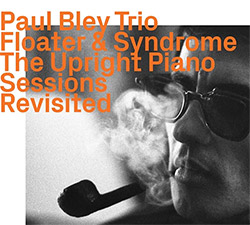
This album was recorded at two different sessions, the first on August 17th 1962, the second on September 12th 1963, both at Medallion Studios, Newark, New Jersey; the musicians at the two sessions were the same, Paul Bley on upright piano, Steve Swallow on double bass and Pete LaRoca on drums. Keen-eyed readers may have spotted that Bley and Swallow had played together in the Jimmy Giuffre Trio since 1961, including recording the classic Free Fall (Columbia, 1963) in 1962 between the two Paul Bley Trio sessions.
In 1963 Savoy released the LP Footloose which comprised eight tracks, three from the 1962 session and five from the 1963 one. In 1984 the label released the LP Floater which had all five tracks recorded at the 1962 session, including Carla Bley's "Around Again", plus two recorded at the 1963 session, Paul Bley's "Turns" and "Ballad No. 4". In 1986, the label released Syndrome which featured the remaining tracks from the 1963 session in addition to a second take of one piece, "King Korn", as well as a 1963 session version of "Around Again". Altogether, Floater and Syndrome included every track recorded at the 1962 and 1963 sessions, which is probably the reason the current release is entitled Floater & Syndrome which includes all of them except the second versions of "Around Again" and "King Korn".
Altogether, Floater & Syndrome comprises thirteen pieces, five composed by Paul Bley, five by Carla Bley who was Paul's wife at the time, "When Will The Blues Leave" and "The Circle With The Hole In The Middle" by Ornette Coleman, and "Stereophrenic" by D Baker. With the tracks' playing times ranging from the 3'17" of Paul's "Turns" to the 7'12" of Carla's "Syndrome", nothing here outstays its welcome and every track is worthy of listeners' undivided attention. Of course, Bley's piano commands attention and is exquisite from beginning to end, even managing to make the upright piano sound like a grand. Swallow and LaRoca provide backing which frames the piano without overplaying or sounding routine. Each of them plays solo when the opportunity permits, giving the music variety and energy. The recording balance between the three instruments is ideal. As ever with ezz-thetics, the sound restoration and mastering are exquisite and, altogether, this release of the 1962 and 1963 recordings will be difficult to better.
Comments and Feedback:
|



